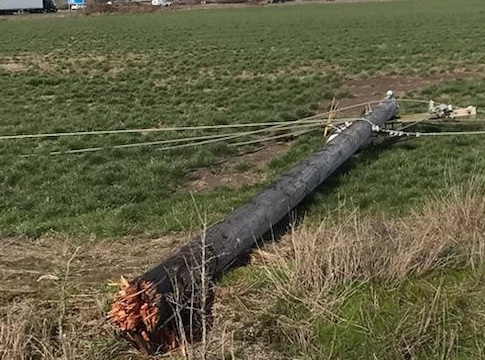Related News
Related News
-
Sustainability Snapshot - Celebrating Energy Efficiency Projects in the Community
Sustainability Snapshops highlight impactful projects completed by EWEB's Customer Solutions department, as a way to celebrate the meaningful work happening behind the scenes.
Find Out More -
McKenzie Valley electric service territory realignment study reaches key milestone
EWEB Commissioners approved a resolution authorizing the General Manager to negotiate and execute agreements with Lane Electric Cooperative regarding a potential realignment of electric service territory in the McKenzie Valley at the Board’s December meeting.
Find Out More -
Women in STEM: Meet the Hydro Project Engineer Building Habitat for Salmon
EWEB Engineer Associate Val Chang found her way to the McKenzie River from Los Angeles, inspired by heritage trips to the waters of Taiwan and key mentors along the way.
Find Out More -
Public Power Week Poster Contest Winners 2025
The results are in! View the winning posters from EWEB's 2025 Public Power Week Poster Contest.
Find Out More -
EWEB Hometown Heroes compete internationally
Out of 290 teams from 14 different countries, EWEB's Lineman Rodeo team places in the top third of competitors.
Find Out More -
EWEB's Halloween Truck-or-Treat is a huge success
Community members are accustomed to spotting EWEB trucks around Eugene streets and neighborhoods. But last week, those familiar vehicles looked a little different. At EWEB's second annual Truck-or-Treat Customer and Crew Appreciation Event, our fleet transformed into a festive Halloween spectacle.
Find Out More -
Let's Talk Turkey. Is your family ready for winter?
We're heading into the holidays, but that also means snow, ice, and not-so-nice weather might be in the forecast. Here are some tips to prepare in advance.
Find Out More -
Vote for your favorite Public Power Week Posters
The top five submittals will receive awards. Help us pick the winners.
Find Out More -
EWEB Hosts Annual Spill Drill to Protect McKenzie River
EWEB led emergency responders in its annual “spill drill” on the McKenzie River on Wednesday, Oct. 15, at the Trail Bridge Campground.
Find Out More -
EWEB Partners with Eugene School District 4J to Celebrate New Kennedy Middle School Emergency Water Station Site
Hundreds of attendees practiced filling up water containers at Saturday's demonstration event.
Find Out More -
Electric Projects underway in North & South Eugene
Underground lines and disaster-resilient power poles are part of EWEB’s infrastructure upgrade near Eugene’s largest natural resource area.
Find Out More -
EWEB general manager to retire in 2026
EWEB launches nationwide search for next leader to continue the progress of the last decade and ensure a smooth transition.
Find Out More -
Quartz Creek: Setting the Stage for Floodplain Restoration
The project resets the floodplain along 1.8 miles of a formerly channelized creek to improve water quality, fish habitat and natural disaster resiliency.
Find Out More -
Join the Pledge to Prepare
When you think about getting ready for an emergency, you probably have questions. You aren't alone. Preparing for emergencies can be overwhelming, which is why EWEB has put together a 12-month program to help you and your family get two weeks ready.
Find Out More -
You can’t predict the next disaster, but you can prepare
The earthquake lasted less than a minute. But now the power’s out. The tap runs dry. Cell service is spotty. Would you be ready?
Find Out More - Show More
EWEB Crews Help Restore Power After Ice Storm
March 16, 2021

After an icy winter storm struck Northwest Oregon in mid-February, bringing down trees and power lines, the state's largest investor-owned electric company issued a call for help.
At the peak of the catastrophe, more than 250,000 Portland General Electric customers were without power amid freezing temperatures. PGE estimated that at least 4,000 power lines were brought down by falling trees, limbs and ice. Several transmission lines were also damaged.
The PGE request for mutual aid landed on the desk of EWEB Operations Line Supervisor John Latourette. After double-checking the weather forecast to make sure snow and ice wasn't supposed to hit the Eugene area, John then determined there were no critical electric projects that couldn't be pushed out for a week or two.
Another consideration in deciding whether to send crews to help another utility restore power is the Coivd-19 pandemic. A utility in California requested mutual aid in January, but EWEB had to decline because the number of Covid-19 cases in the area was going up and the infection rate was well above that in Oregon.
"What would happen if one, two or even three crews came down with Covid-19?" John asked.
He determined the Portland to Salem corridor was at about the same risk as Lane County.
"After checking the weather and the number of scheduled urgent projects, we decided could send three crews and a general foreman to help restore service to PGE customers," John said. Each crew is comprised of four line technicians.
The 13 EWEB staff primarily worked in the Salem and Silverton areas, which were hit hardest by freezing rain that brought about 1 inch of ice to the central Willamette Valley. The crews spent 10 days installing new poles, crossarms and power cable.
"They would come up to some locations where the line was literally pulled down by ice and trees," John said. "Other locations there was one pole that fell, and it took several other poles like dominos falling."
The Eugene area encountered a similar ice storm in December 2016, bringing down trees and power lines. At peak, about 10,000 EWEB customers were without power. After EWEB issued a call for mutual aid, private and public utilities responded to get the lights back on.
Mutual aid contracts require the requesting utility to cover all labor, fuel and materials costs incurred by outside crews.

